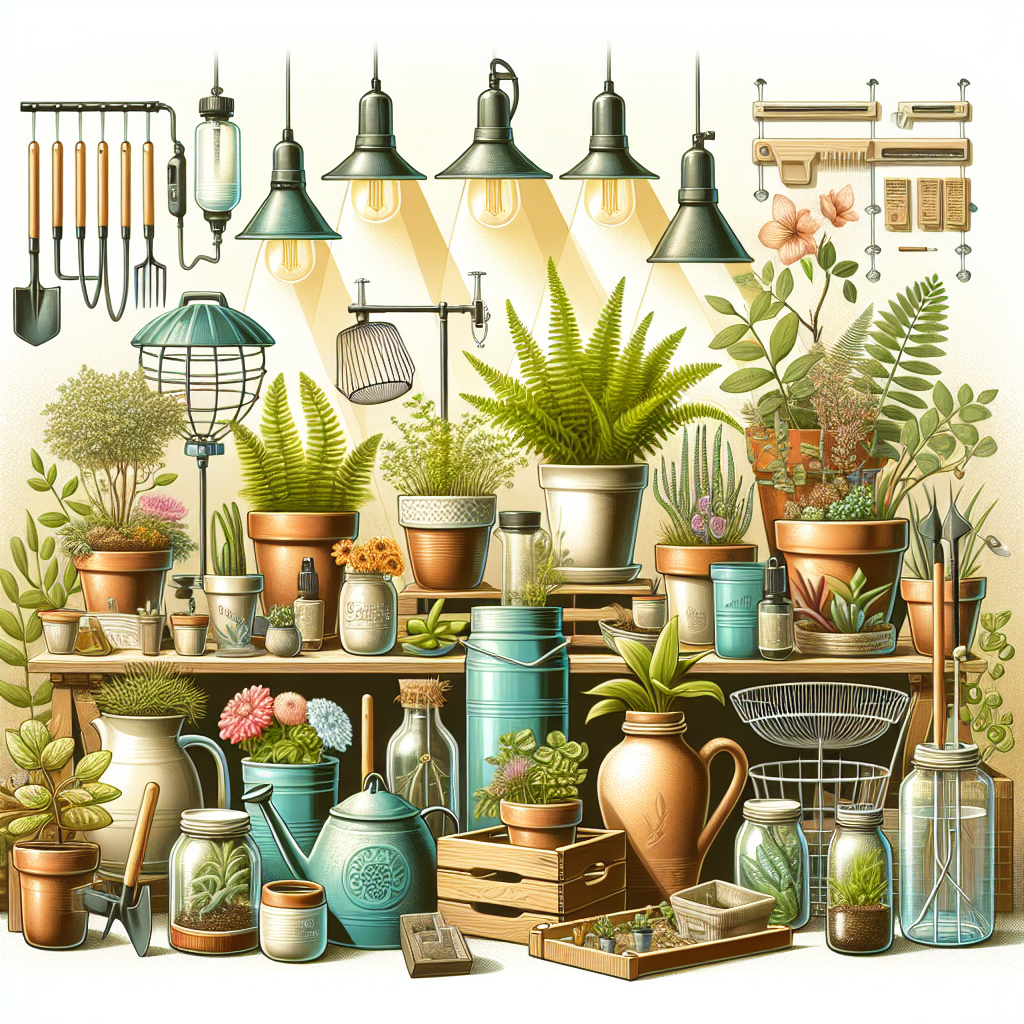How to Prevent Scale Insects on Houseplants
Updated June 27, 2024 at 2:18 am
Discover practical strategies to protect your beloved houseplants from the pesky invasion of scale insects, ensuring they remain vibrant and healthy.

Understanding Scale Insects
Scale insects can be a frustrating challenge for houseplant enthusiasts. These pesky critters are small, tough, and often go unnoticed until significant damage has been done to your beloved greenery. Recognizing the signs of scale insect infection early can make all the difference in protecting your indoor oasis.
Identifying Scale Insects
Scale insects appear as small bumps on a plant’s stems, leaves, or fruit. They might look like shell-like bumps, and these are actually protective coverings over the insects themselves. They come in various colors and sizes, sometimes mimicking the plant’s own color, making them difficult to spot.
Early Signs of Infestation
One of the first signs of a scale infestation is a sticky substance known as honeydew, which is a byproduct of their feeding. If you notice a shiny, sticky coating on your plant or a black sooty mold developing, it might be time to inspect closer for these unwanted guests.
Preventative Measures for Houseplants
Prevention is always better than cure. It’s essential to practice good plant hygiene, including regular cleaning of leaves and checking new plants for pests before introducing them to your home. Quarantining new plants can also prevent the spread of scale to your other indoor plants.
Physical Removal of Scale
If you do find scale insects, prompt action is required. Physically removing them with a soft brush or cloth can be effective for mild infestations. For those stubborn scales adhered firmly, using an alcohol-soaked cotton swab can help to dislodge and kill the insects without harming the plant.
Natural Predators and Organic Solutions
Encouraging natural predators like ladybugs can help control scale insects as part of an integrated pest management approach. Another organic option you might be considering is using neem oil, a natural pesticide, which disrupts the life cycle of scale insects without introducing harsh chemicals into your home environment.
Commercial Insecticides and Treatment
For more severe problems, a systematic insecticide may be necessary. These penetrate the plant and poison the insects as they feed. When using a commercial insecticide, it’s important to follow the instructions precisely and to select a product that’s safe for use on indoor plants.
Choosing the Right Product
In your quest to eliminate scale insects, you might have come across a product like Bonide’s Systemic House Plant Insect Control. Made to target a variety of pests, including scale, it promises to protect your plants for up to two months. Based on reviews, users appreciate its ease of use and effectiveness; however, some are concerned about the use of chemicals indoors.
Pros
- Effective against a broad range of insects
- Easy to apply
- Long-lasting protection
Cons
- Contains chemicals that may be a concern for some users
- Not suitable for all plant types
Find This and More on Amazon
Continuous Monitoring
After treatment, it’s crucial to monitor your plants for signs of recurring infestation. Regularly inspecting your plants is the key to catching scale insects early and preventing them from becoming a larger issue.
Seasonal Considerations
Scale insects can be more active during certain times of the year. Paying particular attention to your indoor plants during the spring and summer months when scale insects are most active can help you stay ahead of potential infestations.
Read more about growing peace lilies, which can be prone to scale insects, to ensure you’re well-informed on how to care for these beautiful, yet sometimes delicate, indoor plants.
Conclusion and Content area 2 of 3
Integrated Pest Management Strategies
Integrated Pest Management, or IPM, is a comprehensive approach to pest control that focuses on long-term prevention of pests or their damage through a combination of techniques such as biological control, habitat manipulation, and use of resistant varieties. Incorporating IPM into your plant care routine helps manage scale insects in a more sustainable way.
For example, companion planting can be beneficial. Some plants can deter pests naturally and planting these alongside your houseplants might prove effective. Pollinator-friendly gardens also support beneficial insects that can keep pest populations in check, indirectly protecting indoor plants when positioned nearby.
Quarantining New Additions to Your Plant Collection
As a diligent plant parent, when you bring a new houseplant home, it’s wise to quarantine it for at least a couple of weeks. This period allows you to observe the plant for any signs of scale insects or other pests without risking your existing collection. It’s a simple preventive step that could save you a lot of trouble down the line.
Maintaining proper distance between your houseplants also reduces the risk of cross-infestation. If scale insects do appear on one plant, keeping some space between your plants makes it harder for pests to spread.
Creating a Healthy Environment for Houseplants
Scale insects often take advantage of stressed plants. Ensuring that your houseplants have the proper care can make them less susceptible to infestations. Appropriate watering, lighting, and fertilization tailored to each plant’s requirements create a robust and healthy plant better able to ward off pests.
Becoming familiar with the needs of specific plants is crucial. Articles like those on Philodendron goeldii care offer in-depth guidance, ensuring you’re informed on how to create the best environment for your plant’s growth.
Safe and Effective DIY Solutions
If you prefer to stay away from commercial products, there are DIY solutions for controlling scale insects. Homemade sprays using ingredients like mild dish soap and water can help to suffocate and remove scale infestations. Another popular mix involves using rubbing alcohol and water for a stronger solution.
Be sure to test these homemade remedies on a small part of the plant first to avoid potential adverse reactions. If the plant tolerates the treatment well, it’s a safe, cost-effective way to tackle scale insects on a larger scale.
Plant Health Check-Ups
Regular health check-ups are as vital for plants as they are for humans. Inspecting your plants weekly can help you spot and address issues like scale insects before they become a serious problem. Paying attention to the underside of leaves and the joints where leaves meet the stem is particularly important as these are common hiding spots for pests.
During these inspections, it’s also a good time to prune any dead or dying foliage, as these can attract pests or become breeding grounds for diseases which can exacerbate a scale insect problem.
Tackling Persistent Scale Infestations
If all your prevention and treatment efforts haven’t entirely eradicated the scale, it may be time to consider a more potent solution. Insecticidal soaps, horticultural oils like neem oil, and systemic insecticides can be very effective when applied correctly.
Remember, some treatments may require multiple applications to fully deal with the problem. Products such as insecticidal soap or horticultural oil work on contact, so ensuring coverage over the entire plant, especially under the leaves, is crucial for these treatments to be successful.
Review of Insecticidal Soap
Insecticidal soaps like Safer Brand Insect Killing Soap are a popular choice for organic gardeners dealing with scale insects. Made from naturally occurring plant oils and animal fats, these soaps are designed to be non-toxic to people and pets but lethal to soft-bodied pests like scale.
Pros
- Environmentally friendly and biodegradable
- Safe for use around children and pets
- Can be used on a variety of plants
Cons
- May require repeat applications for full effectiveness
- Can cause leaf burn if not diluted properly
- Not effective on egg or nymph stages
Find This and More on Amazon
Maintaining Humidity and Watering Levels
Houseplant pests like scale often thrive in environments that are unsuitable for the plant. Scales are particularly fond of plants that are either overwatered or under-humidified. Ensuring that your plants receive the right amount of water – not too much and not too little – along with adequate humidity, is key to staving off pest infestations.
Read about maintaining optimal humidity for indoor plants, like in the guide for cultivating spider plants, to understand the balance needed to keep your houseplants healthy without inviting scale insects.
“`html
Understanding Scales’ Life Cycle
Getting to grips with the life cycle of scale insects can give you an edge in combatting them. These pests go through several stages, from egg to crawler before becoming the immobile adults you often spot. Knowing when they are most vulnerable can help you time your treatments for maximum effectiveness.
For instance, treatments targeting the mobile crawler stage, which is generally in the spring, can be more effective. This is because once the crawlers settle and form their protective covering, they become harder to eradicate.
Frequent Inspection of High-Risk Areas
Some plants, like those with thick or textured leaves, might provide better hiding spots for scale insects. Regularly inspect these high-risk areas to catch any infestations early. Healthy plants are less likely to suffer from pest outbreaks, so maintaining them is essential.
For example, articles like the one on fostering ferns in low light describe plants that prefer high humidity and moisture—the perfect haven for scale. Knowing which plants are more susceptible means you can be more vigilant.
Chemical-Free Approaches
If you’re looking for ways to manage scale insects without resorting to chemicals, considering physical barriers or deterrents could be a viable option. Some gardeners use a layer of diatomaceous earth around their plants to deter not only scales but also other pests.
Be aware, though, that diatomaceous earth needs to be reapplied after watering and is not effective when wet. Always check that any physical control method you choose won’t harm your plants or the beneficial organisms in your home ecosystem.
Revisiting Plant Care Fundamentals
At the heart of preventing scale insects is the health of your plants. Ensuring that your houseplants have the correct light, the right kind of soil, the adequate watering schedule, and suitable temperature will make them less likely to succumb to scale insect infestations.
Whether it’s choosing the right potting mix or figuring out the watering needs of your aglaonema, a plant that’s in its optimal state is your best defense against pests like scale insects.
How to Recover a Plant from Scale Damage
Once a plant has been affected by scale, it’s crucial to help it recover. This means addressing both the infestation and the plant’s health. After treating for scales, give your plant time to recuperate by providing optimal care tailored towards its recovery.
It’s not unusual for a plant to need a period of adjustment after an infestation. Support its recovery by ensuring it receives proper light, moisture, and nutrients. With time and care, most plants can bounce back from a battle with scale insects.
Working with Natural Light and Plant Placement
Strategically placing your houseplants can also impact their susceptibility to scale insects. Plants that require more light but are placed in dimmer conditions can become stressed, making them more prone to pest invasions. Knowing the light requirements for houseplants, as covered in the care guide for pothos plants, is one of the keys to keeping your indoor plants robust and resilient.
Moving plants into areas with better lighting or using supplemental light sources can bolster their health, potentially decreasing the risk of scale insect infestations.
Further Resources and Support
If you’ve done all that you can and you’re still struggling with scale, it might be helpful to reach out to local plant communities or forums. Sharing experiences with other plant enthusiasts can provide you with new insights or solutions that you haven’t yet tried.
Remember, while scale insects can be a relentless foe, with consistent care, attention, and the use of various strategies covered here, you can protect your indoor plants and enjoy a healthy and vibrant indoor garden.
“`
Shop more on Amazon
Flowers & Plants Team
Flowers & Plants Team


